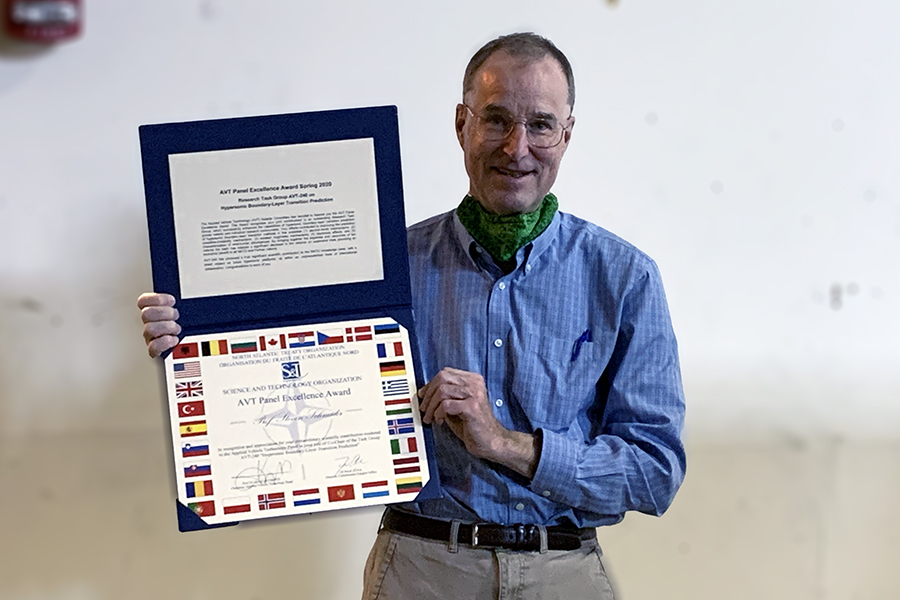Schneider co-chair of research task group that received NATO excellence award

AAE Professor Steven Schneider was co-chair of the NATO Science and Technology Organization (STO) Applied Vehicle Technology (AVT) Panel working on hypersonic boundary-layer transition prediction that won the AVT Panel Excellence Award.
The award was announced during the virtual AVT Fall Awards Ceremony in October.
The mission of the NATO STO is to help position the Nations’ and NATO’s S&T investments as a strategic enabler of the knowledge and technology advantage for the defense and security posture of NATO Nations and partner Nations, its website said. It does that by conducting and promoting S&T activities that augment and leverage the capabilities and programs of the Alliance, of the NATO Nations and the partner Nations, in support of NATO’s objectives, and contributing to NATO’s ability to enable and influence security and defense-related capability development and threat mitigation in NATO Nations and partner Nations, in accordance with NATO policies.
AVT is one of six technical panels within NATO STO that manage a wide range of scientific research activities. Research Task Group AVT-240, which first formed in March 2013, delivered a 400-page summary report on hypersonic boundary-layer transition prediction to NATO STO in March 2019.
Hypersonic boundary-layer transition can have dramatic effects on aeroheating and control authority yet remains difficult to predict, even after half a century of research. Applications include missiles for time-critical strike, hypersonic cruise vehicles, reusable launch and re-entry vehicles and missile-defense interceptors. Hypersonic transition can be caused by several different mechanisms, is affected by various freestream and surface perturbations and can offer under a variety of flow conditions. To develop mechanism-based methods for prediction and control, generic geometries need to be investigated in order to understand the various instabilities that may occur in each case, how they cause transition and their sensitivity to the flow parameters.
The activities of the AVT-240 Task Group were divided into multiple subtasks. Each subtask represented an important building block in the overall problem of hypersonic transition. A number of researchers worked on multiple subtasks, using similar facilities, instrumentation, and computer codes, yielding a significant overlap as well as synergy between the different subtask teams.
The subtasks covered second-mode mechanics; crossflow instability mechanisms; isolated roughness mechanisms; bluntness effects; and the characterization of wind tunnel disturbances.
Substantial progress was achieved in addressing the major problems in hypersonic transition, which prompted the award.
“This award recognizes your joint contributions to an outstanding Research Task Group, which successfully enhanced the capabilities of hypersonic boundary layer transition prediction across nations and individual research communities,” the award certificate said. “By bringing together the expertise and resources of 10 nations, the team has realized the significant decrease in the reliance on expensive trials, providing an economic benefit to NATO and partner nations.
“AVT-240 has produced a truly significant scientific contribution to the NATO knowledge base with a direct impact on future hypersonic platforms, all within an unprecedented level of international collaboration.”
Rolf Radespiel, from the Technical University Braunschweig in Germany, was co-chair of the group with Schneider. Included among the 74 AVT-240 members on the final report were Purdue professors Brandon Chynoweth (AAE research assistant professor), Joseph Jewell (AAE assistant professor) and Carlo Scalo (ME associate professor, AAE courtesy) and Purdue AAE students Joshua Edelman and Kathryn Gray. AAE alumni Matt Borg (Air Force Research Laboratory), Katya Casper (Sandia National Labs) and Bradley Wheaton (Johns Hopkins University) also contributed to the research and report.
“I want to thank the very many different people who contributed to this project in many different ways,” Schneider said during the virtual awards ceremony. “There were about 66 people who co-authored at least one of the 14 chapters in the final reports. Those representatives worked from at least seven different nations. So it was a pleasure to work with so many people from so many different nations on a problem of significance to the whole free world that I hope we can continue this in the future.”
Source: AVT-240 Task Group final report
